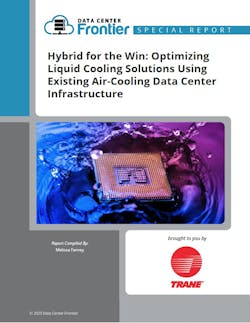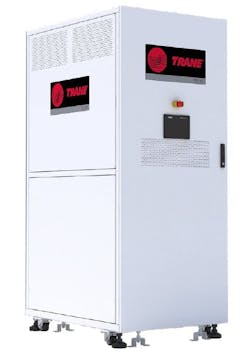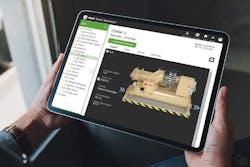We continue our article series on implementing hybrid liquid cooling solutions to navigate the complex interplay of AI, sustainability and operational efficiency. This week, we’ll explore how sustainability and energy efficiency give hybrid cooling systems a competitive edge.
Data centers have a significant environmental impact, consuming vast amounts of energy and contributing to carbon emissions. The energy consumption of data centers is a growing concern, and data center operators are under increasing pressure to reduce their environmental impact. Implementing hybrid cooling combined with robust chiller plant controls strategies and systems to further optimize the hybrid systems performance and efficiency can substantially reduce energy consumption and carbon emissions compared to traditional air cooling or full liquid cooling. By using liquid cooling for high-density zones and air cooling for lower-density zones, data centers can optimize their energy consumption and reduce their carbon footprint.
One of the key advantages of hybrid cooling is the potential for heat recovery and reuse. Waste heat from liquid cooling systems can be captured and used for other applications, such as district heating, industrial processes, or on-site power generation. Capturing and reusing waste heat can significantly reduce the overall energy consumption of the data center and provide a valuable source of energy for other applications. Trane’s solutions facilitate heat recovery by enabling elevated loop temperatures, making the waste heat more readily usable. For example, waste heat can be provided to a district heating grid, housing, or agricultural purposes. If waste heat is provided to housing without means of measuring it, it’s essentially free to tenants. Even feeding heat to a greenhouse can provide additional revenue. Heat recovery can create new revenue streams and reduce the overall cost of operating the data center.
Technical and Implementation Aspects
Transitioning to a hybrid cooling model requires meticulous planning and precise execution. Data center operators must carefully assess their existing infrastructure, workload requirements, and sustainability goals to develop a tailored hybrid cooling strategy or consult with a trusted advisor, such as Trane, who can collaborate to solve challenges. This strategy should encompass key design and operational changes that optimize cooling performance and minimize disruption.
Design and Operational Changes:
Several key design and operational changes are essential for a successful transition to hybrid cooling.
- Moving Cooling Distribution: Traditional data center cooling often relies on in-rack or in-aisle cooling distribution. However, to maximize the effectiveness of hybrid cooling, it’s often beneficial to move cooling distribution to grey spaces — areas outside the white space where servers are housed. This allows for greater flexibility in managing cooling resources and can improve overall cooling efficiency. By centralizing cooling distribution in grey spaces, data center operators can more easily adapt to changing workload demands and optimize cooling performance.
- CDU Placement: The strategic placement of Coolant Distribution Units (CDUs) is crucial for effective liquid cooling. CDUs can be placed in rows along racks, providing targeted cooling to high-density zones. However, an alternative approach is to locate CDUs outside the white space, in service corridors, to minimize disruption during maintenance and upgrades. The choice of CDU placement depends on the specific needs of the data center and the trade- offs between accessibility and disruption.
- Water-Cooled Chillers: As data centers transition to liquid cooling, there’s a growing trend toward using water-cooled chillers. This shift requires careful consideration of the data center’s infrastructure and design. Water-cooled chillers offer several advantages over air-cooled chillers, including larger capacity, higher energy efficiency and reduced noise levels. However, if an open loop is used, they also require a reliable source of water and careful management of water quality.
- Control systems: Trane’s Tracer® chiller plant control harnesses advanced HVAC optimization strategies by using real-time data to make precise adjustments that enhance system performance. With Trane’s expertise, virtually every data center chiller plant can achieve greater efficiency. HVAC system optimization should be a key component of your mission-critical strategy.
Selecting the Right Technology:
Choosing the right liquid cooling technology is paramount for a successful hybrid cooling implementation. Several options are available, each with its own strengths and weaknesses.
- Direct-to-Chip Cooling: Direct-to-chip (DTC) cooling involves circulating liquid directly over the processors, providing the highest heat removal efficiency. This technology is well-suited for high-density zones where maximum cooling capacity is required. DTC cooling can significantly reduce processor temperatures, allowing for higher clock speeds and improved performance.
- Immersion Cooling: Immersion cooling takes liquid cooling to the extreme by submerging servers in a dielectric fluid. This approach offers even greater cooling capacity than DTC cooling and can enable extremely high rack densities. While immersion cooling requires specialized equipment, it provides exceptional efficiency and can significantly enhance data center performance.
Compatibility and Interoperability:
Ensuring compatibility and interoperability between different cooling components is essential for seamless operation. Data center operators must carefully select cooling solutions that are compatible with their existing infrastructure and management systems.
Trane® addresses this challenge by offering comprehensive design and engineering services, as well as pre-validated cooling solutions and chiller plant controls. Trane’s experts work closely with data center operators to ensure that their cooling systems are seamlessly integrated and optimized for performance.
Monitoring and Control:
Effective monitoring and control are critical for managing and optimizing the performance of hybrid cooling environments. Data center operators need to have real-time visibility into cooling performance, energy consumption, and other key metrics. This requires the deployment of advanced monitoring and control systems that can provide detailed insights into the operation of the cooling infrastructure.
These systems should be able to:
- Monitor temperatures, flow rates, and pressures throughout the cooling system
- Track energy consumption by different cooling components
- Provide alerts and notifications when potential problems are detected
- Allow for remote control and adjustment of cooling system parameters
Download the full report, Hybrid for the Win: Optimizing Liquid Cooling Solutions Using Existing Air-Cooled Data Center Infrastructure, featuring Trane, to learn more. In our next article, we’ll discuss the cost implications and return on investment of a hybrid cooling approach and share tips for selecting a trusted advisor.





